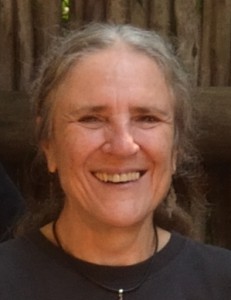Monday
Featured StoriesBreaking Silence
Dispatches from the Front Lines is a new column designed to support the many Shambhalians currently experiencing upheaval at their centers and groups. It is specifically intended to penetrate the sense of isolation common to these painful situations, and to provide a forum for the exchange of ideas and experiences that arise in bringing our conflicts to the path of warriorship. Submissions are welcome!
article by Shastri Jennifer Woodhull, Column Host
Cape Town, South Africa
At first, I imagined that the conflict in our little South African sangha was peculiar to us.
It had to do with our remote location, our newness, a dearth of members with personal experience of Shambhala culture, a personality clash. But as I talked with Shambhalians in Europe and North America, I discovered that we are far from unique. Centers large and small on every continent are experiencing similar upheavals.
Many years ago, I spent some time in an abusive relationship. I had the same illusion back then: I was unique. In particular, I was the only woman in the entire world being beaten up by another woman. But it turned out that a great many women the world over were feeling exactly the same shame, distress and isolation entailed in this illusion. What a relief it was to learn that I wasn’t alone; what a profound healing lay in the ability to speak openly about my experience.
It strikes me that Shambhala today is going through something similar to those times of shameful secrecy. We’re supposed to be building enlightened society, after all. If we reveal the painful schisms, the rigid oppositions, the often petty squabbles in the heart of our own groups, we fear we’ll lose all credibility. And yet at the same time, all our training points toward honesty and vulnerability — the courage to call it like it is, to roll up our sleeves and muck in. It seems to me that, if nothing else, it’s at least time to talk about it.
After a recent and particularly bruising council meeting, I Skyped with my MI (meditation instructor), Acharya Dan Hessey. Dan reminded me, again, that our situation in South Africa reflects a pattern arising in Shambhala centers and groups worldwide. And then he made an interesting remark: “This is the texture”, he said, “of establishing the lineage in the setting sun world.”The texture. I thought of the precise meditation instruction, where we’re encouraged to touch briefly on the texture of our thoughts and feelings. Newer meditators, in particular, often have trouble figuring out what that means. Texture is what we feel when we actually finger an experience, engage with it: when we make a visceral connection with its particular quality.
The notion of engaging the texture of conflict — the immediate and direct experience of upheaval, disappointment, mistrust, blame, despair — puts me in mind of what tends to happen on day three of an extended meditation program. In my experience, it’s then that people reliably hit what Acharya David Hope has called “the reef of neurosis.” I’ve come to appreciate the tremendous creativity that goes into the individual logics that all nonetheless lead to the same conclusion: Enough already — I shouldn’t have to meditate any more.
For some people, it’s a physical issue: my knees, my back, my neck hurts too much. Others decide that meditating this much is a mark of fundamentalism; it’s unreasonable and excessive. Still others spend the morning brewing up a mix of resentment, blame and self-pity: who does this director think she is, to make me sit here and suffer, hour after hour? I recently heard a particularly original reason to stop sitting: “I’m so self-esteemed,” one practitioner told me, “I know how much meditation is healthy for me. And this is way more than I need.”
To use Acharya Hessey’s metaphor, this phenomenon reflects the texture of ego in panic. When our habitual patterns keep failing to talk us out of our meditation practice, they bring out the big guns. Neurosis grabs the microphone, and story lines drown out the erratic music of reality. I think of this outbreak as a sign of success: an indication that our practice is effective enough to pose a real threat to ego’s rule.
Perhaps something similar is happening in the larger world of Shambhala. We’ve accomplished a lot since the first Shambhala center grew up around the Vidyadhara, Chogyam Trungpa Rinpoche, more than forty years ago. In many ways, our groups and centers have successfully planted the banner of the Great Eastern Sun. If my day three parallel holds true, it’s our very success that has brought us up against our collective reef of neurosis. And what we habitually fall back on, in this instance, are the story lines of our cultural era: democracy, psychobabble, neoliberal notions of “justice” and “fairness”.
We’ve been trained to sit through our day three agitation and/or drowsiness. We’re coached to feel the texture of our discomfort, including what it takes to refrain from our habitual reactivities. As Ani Pema Chodron has counselled, “Don’t act it out; don’t repress it; let it pierce you to the heart”.
In our immensely helpful Skype exchange, Acharya Hessey reminded me that the magic of Shambhala lies in the vision of basic goodness and the practice of non-aggression. These are what will endure, long after the squabbles, personality conflicts and power struggles have faded into distant memory. If we’re truly dedicated to building enlightened society, it is to these unwavering reference points that we must return, again and again. And that means letting the painfulness, the injustice, the relentlessness, the pettiness of our conflicts — everything we believe enlightened society is not about — pierce us to the heart.There is no “fixing” these unhappy situations and events. Most “fixes” are driven by hope and fear, which is another way of talking about ego. If we take our dharma and our practice to heart, there’s nothing for it but to stay with the certain knowledge that we will never find solid ground, here or anywhere else. And because we and those around us are hurting, our practice must surely be to extend genuine compassion to everyone involved — always remembering that it’s a practice, not an ideal. For if we are to believe our teachers, it is ultimately this very practice that builds enlightened society: the sane, wholesome, vibrant world that sometimes seems so very far from our sad and fearful quarrels.
Meanwhile, let’s talk about it.
~~
Jennifer Woodhull grew up in Cape Town, South Africa, and returned there after 30 years in the U.S. She took refuge at Karme Dzong, Boulder in 1984 and was empowered as a shastri in 2012. Jennifer is a full-time PhD student in religious studies at the University of Cape Town.








Dec 12, 2014
Reply
Hi–my concern is that folks within and without our sangha will find this page via Google and then proceed to fill in whatever scandal their mind’s can come up with. Honestly–I’m wondering myself, What are these people all referring to? Is there something I should be concerned about? I appreciate the impulse towards transparency, I’m wondering if the vague charges being insinuated here are helpful or harmful.
Dec 5, 2014
Reply
Thank you for all these wise and heartfelt comments. I’m happy to see that this column is already sparking so much discussion—clearly, this is an area in need of much reflection and discussion.
I’d like to clarify some possible misunderstanding right at the outset: it is not at all my intention to invite Shambhalians to air dirty laundry. I completely agree with those commentators, above, who point out that an online forum is not a safe or appropriate place to discuss the particulars of any given conflict. The whole point of this exercise, to my mind, is to remind ourselves and each other that (a) we aren’t alone in our difficulties; (b) being in conflict with other sangha members does not make us failed warriors; (c) all situations are workable; and (d) we actually have the tools we need in order to meet the challenges entailed. Mimi nailed it: “Those of us who have been in this situation … need to be each other’s allies. Not to further solidify the conflict, but to extend our warm, vulnerable hearts to each other.”
The notion that any topic is taboo—particularly one that is causing widespread suffering throughout our mandala—strikes me as directly contrary to our warrior training. Our practice here is surely to truly experience what it means to “lean into the sharp points.” When we do, sometimes we bleed. It’s messy. But it’s real. Keeping it real requires that we take to heart the practices of all four Dignities. Can we wade into the muck and slime of this dark age and actually use the pain, aversion and fear it brings up in us to further those practices? This is the question I’m hoping future columnists will explore in Dispatches from the Front Lines.
Dec 5, 2014
Reply
Jennifer, thank you for opening up this conversation. I fully connect to all the comments people have made here in my own desire to have a safe place to discuss conflict and to bring this conversation out into the open. If we heed the Sakyong’s desire for us to create a culture of “no mistake” we can look at these conflicts, these power struggles, as relative fixations and habits that don’t stain our pure nature. If we examine conflict from our direct experience of basic goodness, then the difficulty, the problems, the anger and frustration will open and reveal their true nature. Organizationally, I am so curious as to where this could take us.
Yet, we need to get to a place where we can sit with each other with enough trust to open our own hearts and minds and in a conflicted situation that can seem impossible. That’s when a trusted mediator could be a support.
I feel the more we practice together as a community the less conflict will arise and the easier it will be to talk about what is happening. Running a centre or group is so demanding we get caught up in attending meetings and teaching and training. We can be too tired to sit together, to do the Shambhala Sadhana together, to show up for a feast or nynthun. I agree with Rebecca. What an excellent idea it is for a group to study The Six Ways of Ruling together. What an excellent idea it is to begin and end meetings with ten minutes of Shambhala Meditation and shamatha. What an excellent idea it is to do a Shambhala Sadhana retreat together and not talk about business, not even once, the whole day.
Those of us who have been in this situation, who are in them at present, need to be each other’s allies. Not to further solidify the conflict, but to extend our warm, vulnerable hearts to each other. We need to be there to listen and to support each other in further opening to the “texture of our thoughts and feelings”.
Dec 3, 2014
Reply
Thank you for sharing. I’ve been struggling for a year with feeling more and more out of step with my local sangha. To the point where I’m on the verge of ending my membership.
Yet, each time I sit or attend a class, I’m refreshed by the Shambhala practices and teachings. And I experience their usefulness on the spot, if I can create a gap, or touch into my feelings, or connect with the basic goodness of the experience.
I’m pondering whether to continue to study and practice on my own, and invest my energy in helping manifest enlightened society in other arenas, or stepping back into the situation in the local sangha. When I contemplate the first, I feel excitement and joy. The latter feels like cocoon, dark, close and stagnant.
Dec 2, 2014
Reply
Thank you for this timely article. For several years, I’ve listened to teachers speak in lofty terms about a culture of kindness and enlightened society. It’s not unusual for people to be petty and vengeful, and then dress it up as “doing the right thing”. I thought it would be different in a community of Buddhists when we hit on the inevitable difficult times. For the most part, it was not.
Dec 2, 2014
Reply
It is interesting to hear this invitation to discuss the upheaval and discord in the centers more openly. Unfortunately, I don’t feel that an online discussion is a safe place to do that, and find myself wondering if there is any safe place to do so. (Which is probably one of the reasons there is upheaval and discord in the centers…..)
Dec 2, 2014
Reply
We can’t really discuss issues here on the public forum of the Shambhala Times, some are so subtle and highly personal. We are also rightly dissuaded in our tradition from speaking ill of others or communities, so we can be mindful and constructive with speech, it’s always easy to find fault. In Boulder, as things were rapidly changing around 2008 with the new curriculum, we tried to reinstate the delek system, calling them sangha neighborhoods. These smaller groups would provide a monthly personal venue for people to discuss issues, and feel welcome. I recall, years ago, I’d get a monthly call from our Dekyong, and he would invite us all to the potluck and he was also keeping his “thumb on the pulse” about each of us in the community. If he picked up on a concern, there could be some follow through with the Desung. I think that individual, grass roots contact with each member, like even a phone tree would be great to invite dialogue and let us all know that we are valued, important, and welcomed, still. Old and new, students alike, everyone is important, and the vision of Shambhala, as I was taught, includes all- students of both or either Sakyong, people that have no teacher like my husband, people that have other teachers, like me. It was my understanding that people of other faiths or none, could so benefit from Shambhala Training, and the excellent and potent practices we offer. Is this still the open, inclusive vision? I’d love to have some tea and discuses this at a delek meeting~ Some creative Shambhala people in Boulder formed their own groups called a Home Club and meet monthly to trade home improvement tasks, and have strong social bonds together. We can do so much, and I ask us to reconsider “Sangha Neighborhood groups, or maybe skype sangha meetings for those who live far from centers. Warmest- Dawn
Dec 1, 2014
Reply
This is such an important issue to bring into the light. Thank you for approaching the subject.
Dec 1, 2014
Reply
Thank you for this. It warms my heart that we are able to acknowledge our struggles and be open about conflict.
Dec 1, 2014
Reply
Thank you brave Shastri Woodhull for breaking the silence. Exploring petty squabbles to rigid oppositions are key to our practice of creating enlightened society. Mediation isn’t something to be feared or avoided. As gentle warriors we should be keen to scent of conflict, especially in our sangha, and explore it right away. President Richard Reoch’s teachings on the “Six Ways of Ruling” (available online) ought to be requisite to any leadership position in Shambhala (they’re brilliant!). Our interactions with sangha need the same care, vigilance, and compassion as working with our own minds. We can do this!
Dec 1, 2014
Reply
this is so true, thank you!
Dec 1, 2014
Reply
Powerful…honesty & bravery are necessary, especially in groups like these. It’s so easy to just go along with what we do to one another and ourselves.